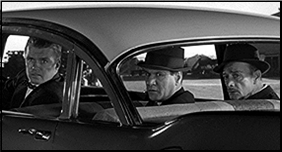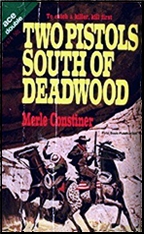Tue 27 Nov 2018
HIRED KILLERS OF 1958: Two Hitman Movie Reviews by Dan Stumpf.
Posted by Steve under Crime Films , Reviews[8] Comments
THE LINEUP. Pajemer/Columbia, 1958. Eli Wallach, Robert Keith, Richard Jaeckel, Mary LaRoche, Emile Meyer, Marshall Reed and Vaughn Taylor. Written by Stirling Silliphant. Directed by Don Siegel.
MURDER BY CONTRACT. Orbit/Columbia, 1958. Vince Edwards, Herschel Bernardi, Philip Pine and Caprice Toriel. Written by Ben Simcoe. Directed by Irving Lerner.
Two remarkably similar films from the same studio, released within months of each other.

THE LINEUP is the more polished and less compelling of the two, largely because it’s a spin-off from a TV series and is therefore obliged to spend some time with the familiar cast plodding through familiar paces — and when I say “plod,†I’m being charitable. After a slam-bang opening, things slog through quicksand, as detectives Meyer and Reed patiently interview witnesses, quietly await lab results, placidly look over crime scenes and impassively conduct the obligatory Line-Up.
Then, twenty minutes into the film, the stillness is broken by the arrival of Eli Wallach and Robert Keith as hit-men hired to retrieve smuggled heroin from three passengers who have carried it concealed in knick-knacks from abroad. And from here on, THE LINEUP becomes a different film altogether: perverse, violent, and non-stop action.

Action yes, but the real interest of THE LINEUP derives from the interplay of the characters: Richard Jaeckel as a cocky driver, Robert Keith as the erudite overseer of the operation (who collects the last words of their victims) and most of all Eli Wallach as the barely-controlled psychopath who does the killings.
Wallach is quite good here, moving with staccato grace (His character is appropriately named “Dancer.â€) and darting knife-sharp glances at his potential targets like a bomb looking for an excuse to explode. But the character wouldn’t be nearly as effective without the interaction between him and his cohorts, skillfully laid out with Silliphant’s dialogue and knowingly evoked by Don Siegels’s economic direction.

If you take THE LINEUP, slash the budget and cut out the dull parts, you’ve got MURDER BY CONTRACT, a lean, mean and artful 80 minutes of down-and-dirty crime drama.

The structure and characters here are pretty much the same as in the earlier film: Vince Edwards is Claude, a creepily emotionless hit-man brought out to L.A. for an important contract and given two wheelman/watchers: Herschel Bernardi as the older, thoughtful type, and Philip Pine, immature and loud-mouthed.
And again, it’s the relationships between the principals that livens the story, even as Ben Simcoe’s screenplay zips things along. Like THE LINE-UP, CONTRACT breaks the story down into three segments, as Edwards & Co. make tries on their target, with deadly results.

But where THE LINEUP gets mired in detail, MURDER BY CONTRACT will have none of that — maybe because it was made for roots & berries. Whatever the case, CONTRACT cuts the narrative down to its bare bones, with elliptical editing, cramped sets and spare background music by Perry Botkin that literally underscores the killer’s alienation.
And when, like Dancer in THE LINEUP, Claude finds himself alone, his physical solitude is a mere formality. He always was an outcast.







